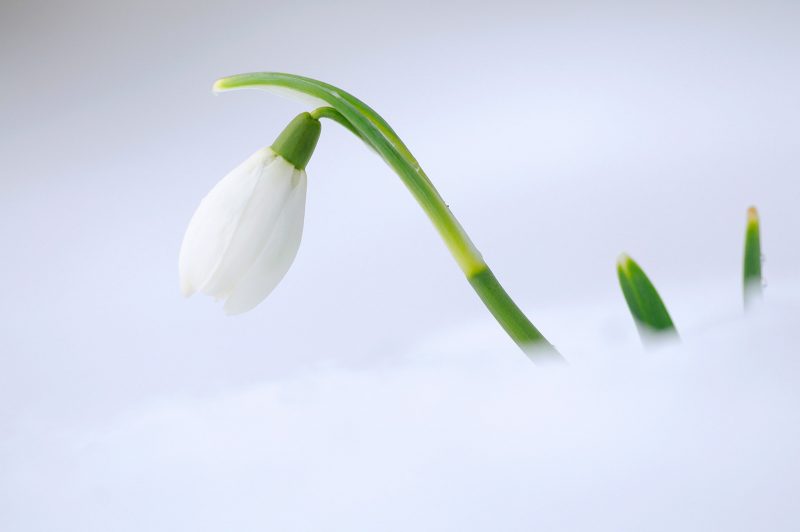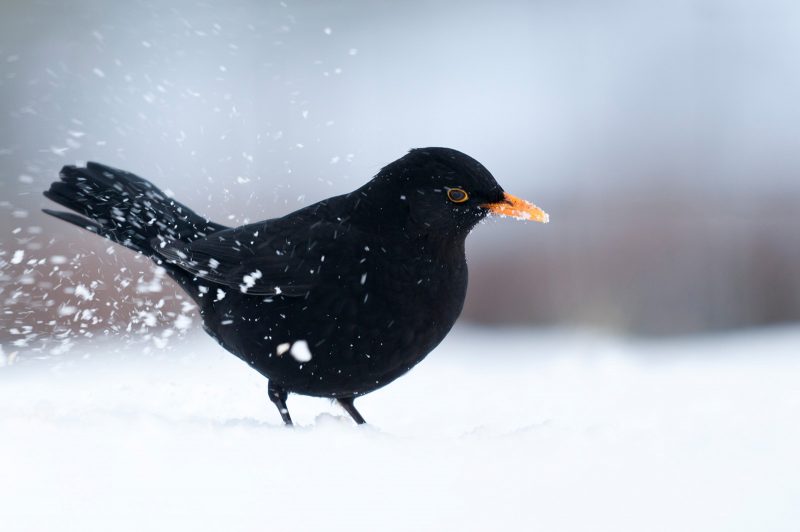Back Garden Wildlife Photography in the Snow

One of the key ingredients to capturing great landscape or wildlife images is planning. Today, outdoor photographers are typically well organised and informed. We can thoroughly research our subjects and potential locations online before planning a photo shoot. Apps like The Photographer’s Ephemeris and PhotoPills help us to remotely predict the position of the sun or stars, whilst there are countless weather apps to help us predict what the weather is likely to do. Planning greatly enhances our chances of taking great images… but what do you do if all your careful planning is laid to waste by the weather?
Winter is understandably a favourite time of year for landscape and nature photographers. Glistening frost or a deep carpet of snow is undeniably photogenic. Snow in particular has the ability to transform the outdoors into a beautiful and unfamiliar winter wonderland. It simplifies the landscape, reducing the impact of distracting elements and emphasising more interesting ones.



Snow creates a stark, simple and stunning backdrop to nature shots. Wildlife tends to be easier to locate and more likely to be enticed close to camera by food or water. Without a doubt, wintry conditions are among the very best for photography. But what do you do if the conditions get so bad that you dare not venture out in anything but a 4×4? Or you simply have limited time to make the most of the seasonal conditions due to work or family commitments? The answer is that you have to stay close to home and be more impromptu – visiting scenes within walking distance of where you live, or taking photos within the boundaries of your own back garden. While this might sound limiting, you just might be surprised at what you can achieve.

I’ve always been a big advocate of working close to home. An intimate knowledge of the wildlife or landscape within a short drive of where you live will often help yield good results, and doing so lessens your carbon footprint too. Admittedly I’m lucky to live in rural, picturesque Cornwall, but wherever you live – rural or urban – snow and wintry weather will always create opportunities. For example, a couple of years ago it snowed and snowed and just didn’t stop. The roads quickly became inaccessible and, much to the kids’ delight, we got snowed in. Photographers like choice and, at first, I felt frustrated and limited. Places I would automatically choose to go – like moorland and elevated viewpoints – were impossible to access. However, I quickly recognised that being stuck at home without a plan didn’t necessarily have to be a bad thing. The wildlife and views that you see and pass-by everyday – and probably take for granted – become your focus instead, and you begin to recognise and appreciate the opportunities on your doorstep.
I started in my back garden. Obviously I began by making a rather impressive snowman with the kids, but once that was done, my daughters were banished indoors and I went and got my camera. Although I don’t do a lot of bird photography, winter is the best time to photograph the birds visiting the garden. Most of us have nut or seed feeders hanging in our backyards – and if you do too, then you already have a feeding station up and running, enticing birds to a predefined place. With natural food in short supply, birds will feed frantically. Wildlife needs all the help it can get in freezing conditions, so I put out lots of suitable and safe wild bird food. Not only was I helping them, but doing myself a favour too.
The more birds you can encourage into your garden, the more subjects you will have to photograph. Wildlife understandably grows more tolerant of human contact when hungry, so I didn’t even need a hide – I just quietly lay down on our snow covered lawn (approx. 3-4m away from our bird table) and began shooting the birds below the table that were eating the seed I’d scattered around. Alternatively, you might decide to use a small dome hide, or shoot from an open window or garden shed. Personally, I wanted a low, ground level perspective. This allowed me to achieve a more intimate view of ground feeding birds like blackbirds and robins, and blur the foreground snow to create an attractive soft, white frame.
Lying in the snow proved to be as stupid as it sounds. It was cold – very cold. However, lots of good, thermal layers made it bearable. I wore thin liner gloves to protect my hands, but allow me to still feel and use my camera’s controls. I opted for a higher ISO and continuous shooting to help freeze movement and action.
I spent much of the first day out in my garden – less than 15m from my front door. When I got too cold, I headed indoors, sat by the fire and ate mince pies – there are many benefits to shooting near home! I enjoyed being close to the animals that reside in my garden, which I typically overlook as subjects. I got to know them better – appreciate them more. I took hundreds of shots – why not? With wildlife you often have to play the numbers game and shoot big sequences to ensure you get the shot. I used an 80-400mm tele-zoom on a DX, cropped-type SLR to enable me to get frame-filling shots of small subjects.
The snowy white backdrop created a nice, clean background for my subjects, helping them standout boldly and creating a high-key look. I took some nice shots; I obviously took some terrible ones too. I found it incredibly satisfying to be taking decent photos in my own back garden – far more rewarding than had I travelled miles, or rented a hide somewhere, to achieve my shots. You don’t have to be snowed in to take advantage of the opportunities staring you in the face at home, though. Remember, the opportunities are ever present – whatever the weather. If you need further persuasion or inspiration, read Back Garden Safari by Richard Peters.
First and foremost, I’m a close-up photographer – I’m far more comfortable with a macro lens than long telephotos. Wintry weather can transform even the most mundane subjects. Frostbitten holly and ivy looked attractive in close-up, and I also noticed a handful of snowdrops poking up above the snow on a grassy bank bordering a neighbour’s garden. Obviously, I asked permission before taking shots in their garden. They clearly thought I was bonkers lying down outside their house photographing something as commonplace as snowdrops, but again the snow created the most fantastically simple, flattering and seasonal backdrop.
If you prefer something a little more abstract, look at the patterns created by frost on windowpanes, or the detail and structure of ice. From a technical viewpoint, close-ups like this are not hard to capture – it is the ability to ‘see’ the shot in the first place that really matters. If you don’t own a macro lens, try using the long end of a tele-zoom or attach an inexpensive close-up filter. Again, the wintry conditions (and inability to drive anywhere) helped alter my perception of some rather ordinary subjects.
Further Reading: Introduction to Macro Photography: Equipment
Obviously, you don’t need to be snowed in to take advantage of the opportunities close to home this winter. In many parts of the UK at least, snow or extreme cold is uncommon and, when they do occur, photogenic conditions might only last a day or so. If you are having to juggle work or family commitments, you will likely have limited time to get out with your camera – which is yet another compelling reason to limit travelling time and focus on the opportunities you can find within your own neighbourhood. Even a light dusting will transform rural or urban scenes, and the countryside within a few miles of my home looked like a winter wonderland after all that snow.

Scenery that I drive past everyday and largely ignore had been transformed by the wintry conditions, and so I set off on foot to look for big views to shoot. After snow, look for key elements – like skeletal trees, a church spire or key landmarks – to include as a focal point within the landscape. Maybe try including a country road, lane or footpath to act as a lead-in line. Soft early morning or late evening sunlight will cast long shadows, which can look particularly striking stretching over virgin snow. Bright, white snow can cause a few exposure problems for TTL metering systems, typically fooling them into underexposure. Therefore, keep an eye on your histograms and dial in positive exposure compensation if required. Thanks to the wintry weather, I was discovering shots and viewpoints just a short distance from home that I had never even given a second glance before. It was enlightening, exciting, fun and satisfying.
Further Reading: Understanding Histograms and How to Use Them
So what’s the moral to the story? I guess what I’m trying to say is that things don’t always go to plan! As an outdoor photographer, you need the ability to react positively when a spanner is thrown in the works. You have to be able to be spontaneous and turn a negative into a positive. And sometimes those positive opportunities are just staring you in the face, right on your doorstep!









